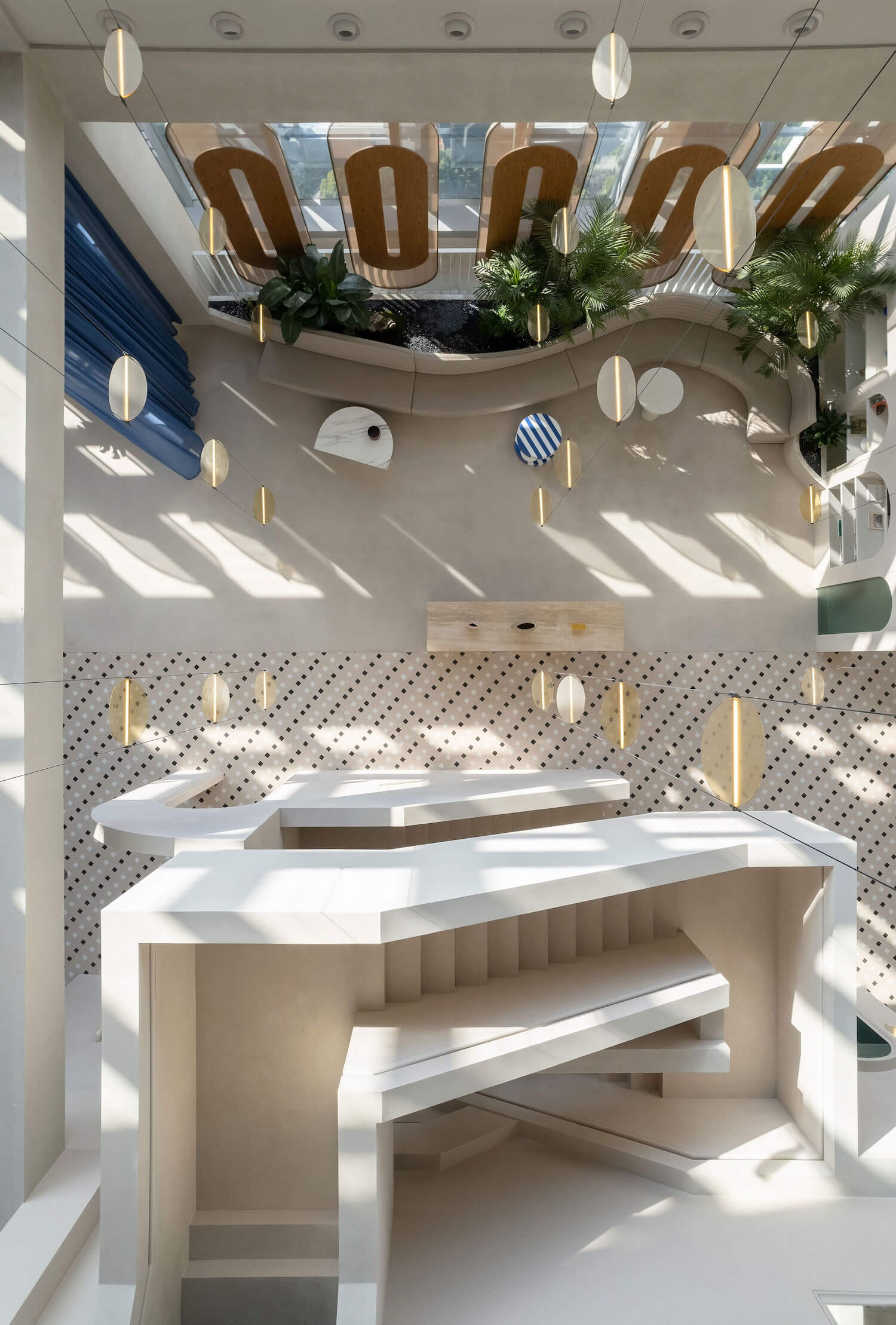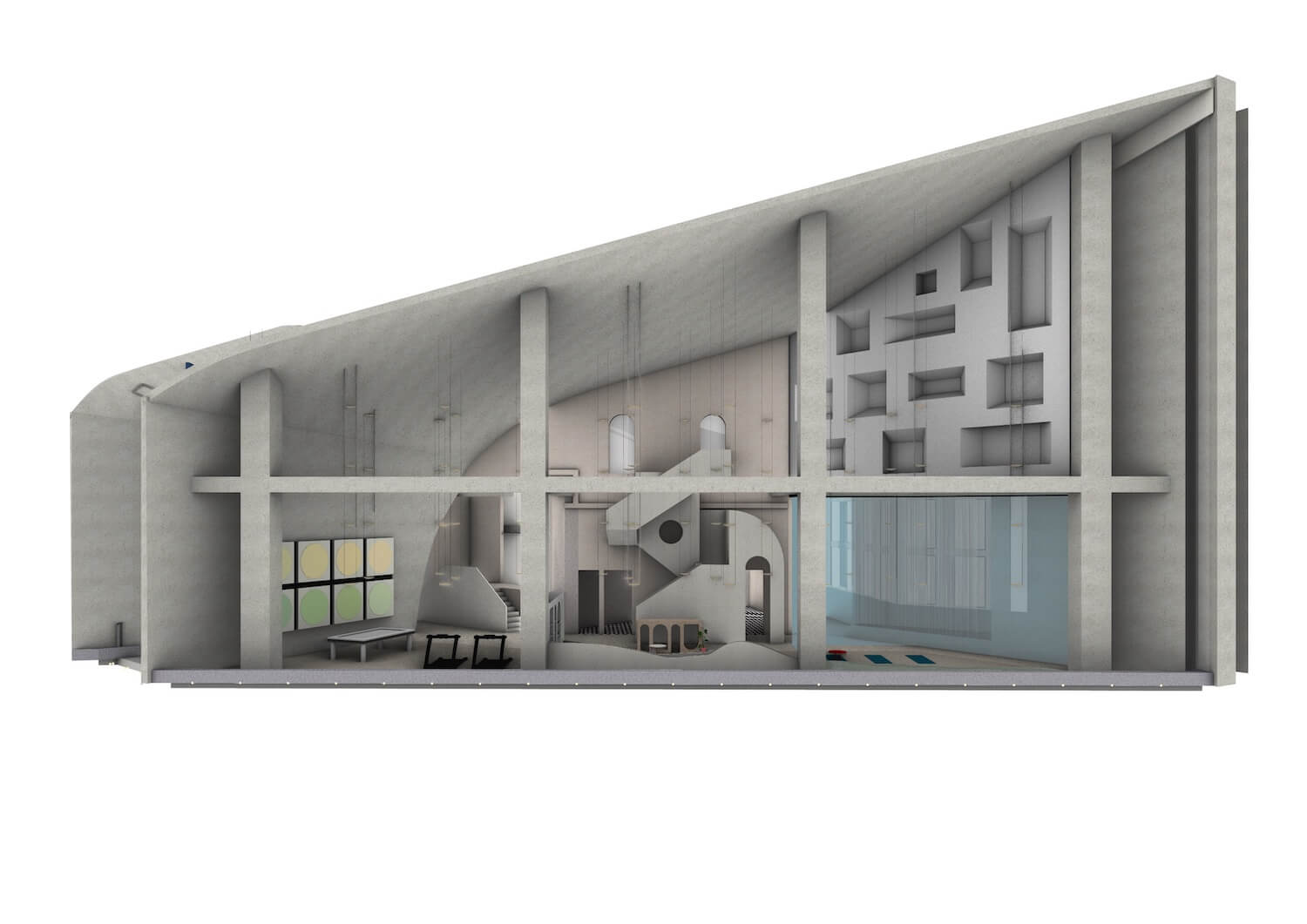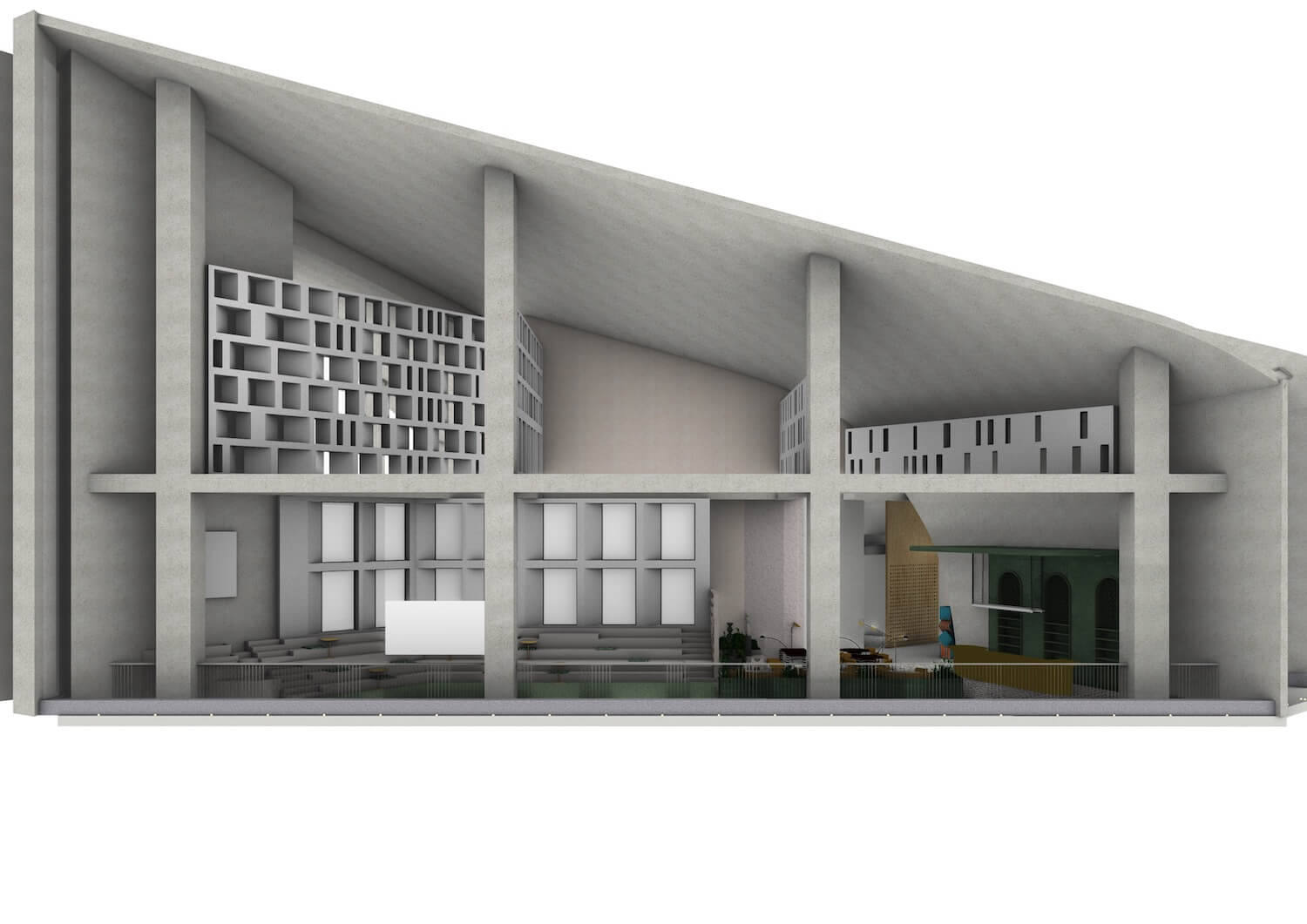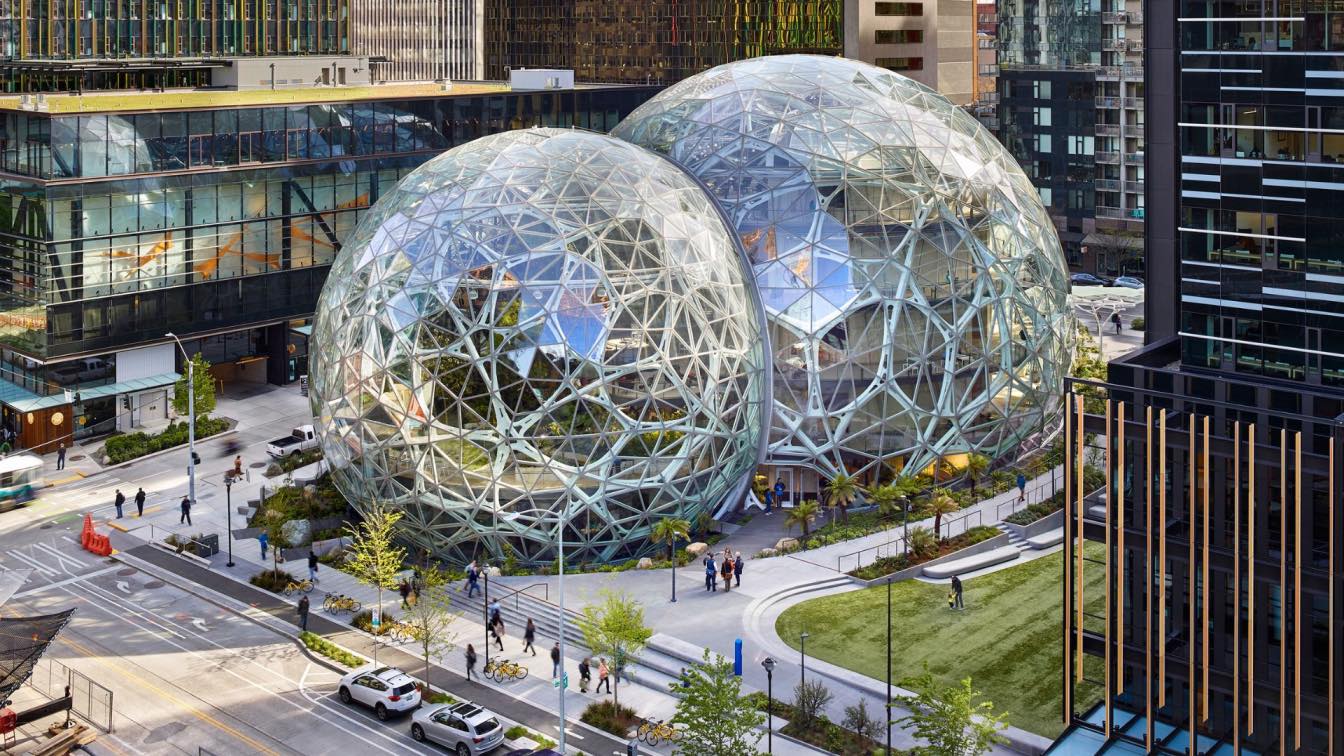Preface:
The stage is tall and refined, the garden is warm, With abundant sunlight, and the elegance of a still life, Layers of geometric forms and curves, light and shadow, Subtly emerge and overlap, Reflections in silence, A place for leisurely exploration, We create emotional connections, Between people and space.
Design Concept
The city of Taizhou is situated in an impressive landscape within Zhejiang province in China, and embodies the local motto “Seven mountains, one river, and two fields”. It is home to Tengda Center, a landmark high-rise building, whose architectural language was inspired by the structure of the osmanthus flower. Tengda Center is the first project to combine art and social spaces in Taizhou, embodying the concept of "an exquisite, aesthetically refined urban living room", bringing a new way to experience art, life, and leisure in the city.
Lingli, Head Designer of TALES Creative, has incorporated the painterly concept of Cubism to inform the composition of colors and the spatial relationship between various elements in the project, allowing the space itself to serve as a kind of canvas. She has also drawn on the forms found within mountains, seas, and water to shape the project, which includes a leisure garden area, hidden tea room, exhibition area, and spaces for relaxed socializing.
Area 1 – Leisure Garden
Area 2 – Forum Valley
Area 3 – Exhibition Space
Area 4 – Hidden Tea Room

Journey Into Art
Taking inspiration from the concept of Cubism, spatial aspects and art are integrated accordingly, achieving a sense of flow throughout the roof garden. Visitors are invited to explore here, akin to discovering unique and surprising artworks though a series of dream-like spaces.
A-Entrance Hallway
Upon entering the rooftop garden, the first space guests encounter is the Entrance Hallway, whose design concept is based on the painting "Little Harbor in Normandy" by Georges Braque. A sailboat navigating wind and waves is a metaphor for the entrepreneurial spirit of Tengda Enterprises, while the lighthouse provides a symbol for its aspirations, which have resulted in decades of accomplishments. The overall design of the entrance hall also pays homage to the company’s endeavors: the sculpted staircase and rounded acrylic chandeliers suspended in mid-air are an interpretation of Tengda’s intentions to voyage through the rough sea of an uncertain marketplace, and find its way safely to the top.
Courtyard
Marc Chagall's painting "I and the Village" presents an aesthetic fusion of nature and abstraction. The Courtyard’s design adopts this approach, with the seating area’s plants distributed amongst blue curtains, pink décor, and white/striped coffee tables, which all contribute to the alluring color scheme here. The forms of the furniture are defined by multiple combinations of rectangles and circles, providing a source of creative, abstract visual delight for visitors to the space.

ZEN Yoga
Picasso's painting "Jacqueline with Flowers" expresses the essence of a woman’s elegance and innate charm through an upright posture and dignified character. Her tall presence provides a precedent for the design of the Yoga Area on the rooftop, which happens to be located on the uppermost level of the space. During the practice of yoga while sitting calmly, the breath is brought from the body’s center to the head, and is in effect pulled up towards the sky. Sitting serenely amongst the space’s plants, visitors can enjoy a moment of mindful silence and inner peace.
The Forum Valley: Relax and Socialize
The Forum Valley space draws inspiration from countryside landscapes, its form approximating the shape of valleys found in nature, and offers an abundance of green plants and flowers to create a vibrant and pleasant atmosphere. Recalling the painting "Castle at La Roche-Guyon" by Georges Braque, this space presents subtle modulations of light and shadow, allowing visitors to relax and enjoy one another’s company in an inspiring and creative setting.
GARDEN CAFE
Upon entering the Garden Café area, visitors are presented with black and yellow ochre floor tiles, round black and white tables, and cushioned yellow chairs and benches. Taken as a whole, the ambience is reminiscent of the abstracted objects emerging out of Georges Braque’s painting “Fruit Dish and Glass”, its drink glasses and kettles immersed in the space of the canvas seemingly exuding a strong scent, translated here to the pleasant aroma of fresh beverages and snacks served in the café. Against a lush backdrop of tropical plants, with an impressive view overlooking the city and the pleasant aroma of fruit and beverages in the air, an afternoon spent here has a unique quality of aesthetic refinement, naturally pleasing to the senses.

F-Roof bar
The Roof Bar area is the bartender's stage, offering a warmly lit and inviting atmosphere with a color palette evoking wheat fields ready for harvest and freshly brewed beer. The combination of the curved, deep green resin wall with panels of polished brass lends a quality of lush richness here, similar to the atmosphere evoked in Braque’s painting “Houses at l’Estaque” with its verdant trees playing off of yellow ochre houses.
VIP LIFT LOBBY
The VIP Lobby draws inspiration from “Abstraction (Guitar and Glass)” by Juan Gris: in the painting, the guitar and glass evoke music and wine, symbolizing people’s yearning for leisure and a better life in general. These values are also representative of Tengda’s vision: to improve people’s quality of life through excellent infrastructure and environments of distinction. The miniature garden here and the subtle guitar and glass shapes embossed on the wall form an instantly soothing atmosphere, a spatial version of natural background music.
H-Shen Lounge
Shen Pavilion is the name that was given to the first teahouse. Written in Chinese, the characters for Shen, “屾”, portray two mountains adjacent to one another and stand for stability, which provides the base for a proper tea-tasting environment. In a social context, this implies sharing tea and a chat with close friends in the Pavilion. In ancient China, the image of rushing water over high mountains symbolized the sentiment that a close friend is difficult to find.

HUI LOUNGE
The Hui Lounge represents the three "mountain" and is grouped together with the other lounge areas, serving as the reception and rest area. From the space’s overall composition to the immaculately polished furniture and custom-made vases and rugs, the concept of Cubism is integrated throughout. The result is the creation of a place where landscape elements seamlessly coexist with the architecture, and provide a unique floral fragrance throughout the space, giving guests a memorable sensory experience combining the visual and the olfactory.
J-MANG LOUNGE
The group of four "mountain" is grouped adjacent to the others: the Mang Pavilion, a place dedicated to more formal meetings. Taking compositional and aesthetic cues from Picasso’s work “Landscape with Bridge”, the space’s colors and forms allude to bridges, water, and natural scenery, while its proportions are tall and straight, recalling the architecture of the painting. Meetings and discussions in this innovative space can benefit from its atmosphere of creativity and vitality, contributing to the development of new ideas and intriguing collaborations.
K-EXHIBITION SPACE
For the Exhibition area, we have followed the example of Juan Gris’s painting “Violin and Guitar” by employing repeated geometric forms and colors to compose the space here. The combination of green acrylic display panels and black arched lamp armatures creates an architectural rhythm reminiscent of the flow and timing of violin and guitar music. At the same time, we have taken Tengda’s philosophy of “Imagining a better life” and incorporated transparent frames displaying images of various activities, as a means of attracting guests to explore the visions of the future displayed within them.
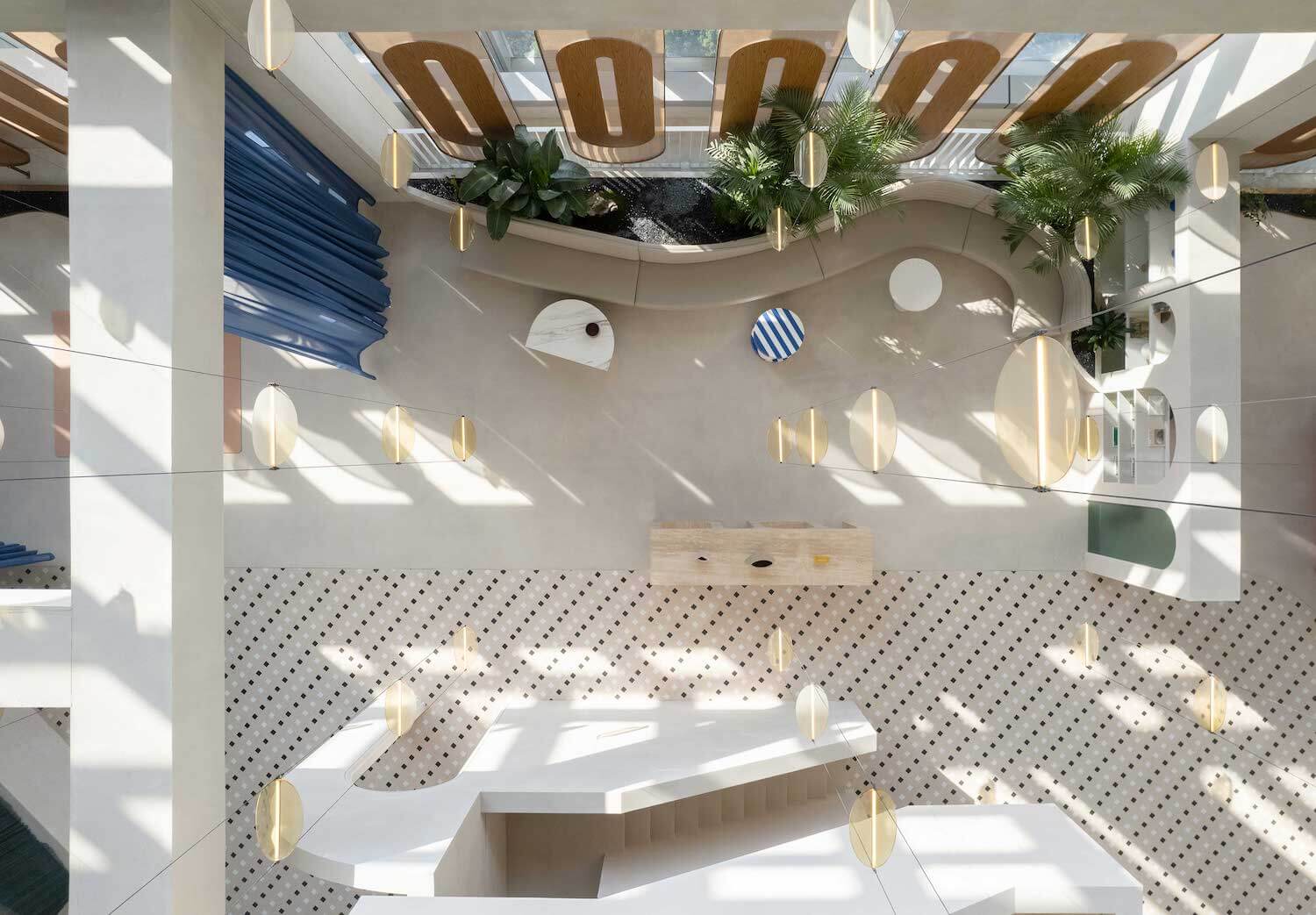
L-Restroom
The functional and symbolic value of windows have long been a source of fascination for many artists. The Rooftop restroom’s stained-glass windows draw from Delaunay’s painting “Saint-Séverin” and its calm portrayal of elegant arches arrayed throughout the length of a church. The space and the painting share aspects of color, respectful privacy, and classic modernity in their rhythm and composition.
In taking inspiration from a range of important cubist art, TALES Creative has created a series of tall, sunlit spaces rich in sensory experience. Elegantly stylish combinations of color, texture, and changes in atmosphere evoke a range of pleasant feelings and emotions. The senses are awakened here akin to Tengda’s desire to demonstrate the diversity and potential of human aspiration through its work. These lively, creative spaces ultimately embody the company’s motto of “Imagining a better life”.
